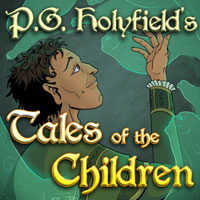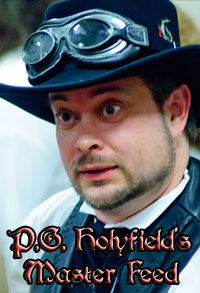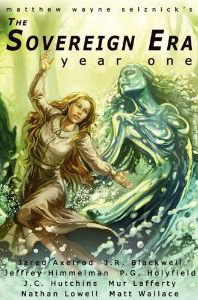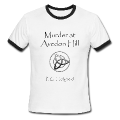Timeline
“The one god, Az, thought upon his existence and this thought created the universe. He breathed, and this breath created Caern. He spoke, and these words created all life on Caern. He looked over his creation, and this glance created the river of magic that flows throughout Caern. And Az so loved Caern that he cried; and from these tears his Children were born.”
16000 – 8000 BI (Before Iberian) – “The Quiet Time” – The old races, Elves and Dwarves, live in various areas of the only known continent of the world called “Caern”. There is some interaction between these races, but mostly they keep to themselves. The greatest threat to this peaceful existence comes from small orc and goblin incursions from the northern mountains.
On the other hand, this era is anything but “quiet.” Myths and legends from the first half of this age speak of the unrestrained impact the Children of Az had on Caern. The Children of Az fought constantly on their plane of existence, over their powers, over their position with respect to their father, over anything that entered their minds on any particular day. The Children also found they could enter and exit Caern at their leisure. These verbal and emotional conflicts in heaven led to physical confrontations once on Caern.
The Children quickly came to understand that they could die, but death on the physical plane of Caern only returned them to their heavenly plane. Some of the Children kept out of the fray, including Balin and Elai. Others such as Arjun, Iruna and Kaelee sought to help those living on Caern. But the other Children had no problems using Caern as their personal battleground, and began using the living creatures of the Land to fight their battles against each other. These wars were waged for many reasons, some valid (to the Children in any case) and others simply as part of some grand game between the gods.
8000 – 7800 BI – “The Dark Times” – For the first time during the Land’s history, there is a concentrated attack against the races of Caern which lasts almost two hundred years. A connection is made much later in history: the games of the gods resulted in tears in the fabric of the universe. Through these holes between the physical plane and others (Kalin’s Abyss (the Land of the Dead), Outworld (what the Priests of Caern call the land where various denizens of evil exist) and other unnamed places) flowed what were later named the Tourim. These creatures of darkness, both living and undead, nearly destroyed Caern. Only the combined might of all the Children, along with thousands of elves and dwarves, were able to banish the Tourim from Caern. It is widely believed that these forces of evil were controlled by some unseen power.
Around this time is when Az felt the need to rein in his Children, creating what is now called the Constraints of the Children.
The Constraints (as the Priests of Caern describe them) are as follows:
- a Child can still enter Caern by conscious choice
- The Child would be born into the world as any mortal being. He or she could influence their race and area they would be born, but there would be no guarantees. Az chooses the mortal mother for this Child.
- The Child would have no knowledge of their true nature – they are born into the world as a baby, and would grow as any mortal child would.
- Only through an epiphany can the Child learn their true nature. Examples of triggers of epiphanies:
- acts of heroism
- acts of sacrifice
- Revelation by another Child that has already realized its nature.
- Once a Child receives its epiphany, it may or may not receive “full disclosure” of its past. If Az desires certain facts or knowledge to remain unavailable to the Child, that’s how it is.
- While still being very mortal, a Child that has received its epiphany has access to many powers, but certainly not the powers the Children possessed when they nearly destroyed Caern.
- A Child can live its entire life and die without ever realizing its true nature.
6000 – 4000 BI – “The Human Intrusion” – Humans begin appearing in western Caern around 6000 BI. The older races keep a watchful eye on this new race. Humans build settlements that grow into towns and small cities, especially on the western coast. For five hundred years humans continue to emigrate from unknown lands to the west. No records exist detailing what these lands are and why man had fled from said lands. Trade was not the reason for man’s arrival. No ships ever attempted a return voyage east.
Around 5500 BI, ships cease arriving from the west. After this time, a few humans begin to train with elven mages. Gnomes also begin appearing during this time. Some today feel this race grew out of unions between humans and dwarves.
Those so moved to study the ways of the accepted deities of the Old Races were free to come and go to the many dwarven temples located in the mountains and hills of central Caern. Temples to these and other deities begin appearing in the coastal towns. While no true regional governments arise during this time there are various guilds and religious factions that begin to wield power.
4000 – 15 BI – “The Silence and The Exodus” – Over time contact between the new and the old races becomes more limited. Human historians claim that the long life spans of the older races and the expanding territorial nature of humans cause the older races to lose patience with humankind. Schools of magic and temples of learning close; by 1000 BI visitors were no longer welcomed in the “Old Places.” Soon elves and dwarves begin appearing in the new cities, rarely speaking of their homes or sharing what had happened to make them enter human society. Human explorers searching for an answer by travelling to the “Old Places” find nothing but abandoned cities after 300 BI.
15 – 1 BI – “The War of Man” – The towns of Durst, Khardia and Khisdel in northern Caern are razed by an army of goblinoid creatures in 15 BI, starting what would become known as the “War of Man”. The attacks do not seem as organized as the ones during “The Dark Time”, yet the sheer numbers of these creatures produce a fear that hasn’t been seen in Caern for almost six thousand years.
14 BI – Theuroik Ironblade, leading a loose knit band of warriors, strikes a blow against the goblinoid hordes by turning back an attack at Haven.
12 – 5 BI – Iberian – A young cleric named Iberian begins preaching in the southern city of Dolman Tear, at the Temple of Arjun. He claims to have knowledge of the one true god which he calls Az. He is run out of the city. Over the next eight years he gains a multitude of followers, many due to the fears of the growing armies of darkness. He publishes his first religious work in 8 BI, and forms a commune that draws over 1000 followers by 6 BI. His main tenet holds that the deities of the old and new races are all manifestations of one of the ten children of Az, and that the attacks of what he names the demonspawn are a call to heed his teachings.
9 – 5 BI – Theuroik’s army has grown to 3,000, but he is forced to retreat from his home city of Pendar under the onslaught of at least 7,000 orcs, goblins, and gnolls. He vows to take back his home before the war is over. Theuroik and Iberian meet for the first time in 5 BI in Iberian’s self-governed community. No one knows what transpired during this meeting; it is assumed that while a friendship was not forged, both recognized the need for the other if the war was to be won.
5 BI – “The Wall” – Following the fall of Pendar, Theuroik’s army builds what becomes known as “Theuroik’s Wall”. It is a mostly symbolic gesture against the inevitable attacks from the north. The wall extends from the western coast south of Pendar to the western forests south of The White Plains.
4 BI – “The Towers” – A line of towers are built along the western coast of the Land of Caern, a communication system that would be used to send word to the southern cities of Yew in case there is a break in Theuroik’s Wall.
2 BI – “Liza’s Choice” – The armies of evil, numbering over 12,000, bolstered by creatures never before seen in Caern, break through Theuroik’s Wall and head toward Ohme, the largest city in Caern. The “towers” serve their purpose, providing Ohme two day’s notice before the army’s attack. Theuroik, now reinforced with over two thousand cleric/fighters aligned to Iberian, decide to make their final stand at Ohme. Theuroik holds the city of Ohme for three weeks, turning back wave after wave of attacks. Abruptly the attacks cease for two days. Theuroik watched the fires outside the city walls grow in number; he fully realized his army would not be able to repel the next attack.
The next morning almost 8,000 monsters charged in a final push to breach Ohme’s walls. With only hours left before the city would surely fall, Theuroik was stunned to see fire begin falling from the sky. A small band of elves, dwarves, and gnomes, led by the elf queen Elisia Llewellyn had arrived. Magics coursed through the air, and Theuroik recognized this was the chance he had been waiting for for over ten years. Realizing that the small band made up of the Old Races would be destroyed quickly without his aid, Theuroik and his army charged out of Ohme. The armies of evil suddenly found themselves attacked on both sides. Iberian, with a small strike force discovered the demon that had led the demonic and goblinoid creatures into battle and smote him. This broke whatever link that had allowed the “demonspawn” army to work together. The army broke ranks and fled north.
Theuroik and Iberian met Elisa Llewellyn at the center of the battlefield. While the ‘Old Places’ had been abandoned by the ancient races, the ‘Old Ones’ themselves had only retreated further into secret places in the forests and mountains of Caern. Elisia stated that she had watched the actions of man during this war and against the wishes of many of her kind, she had decided that it was time to act on man’s behalf. She had gathered as many of the ‘Old Ones’ that had believed in her cause. Ohme would later be renamed “Liza’s Choice” in honor of the elven queen.
An order of paladins comes into existence out of this battle, named the Knights of the Rose. Their duty is to protect the clerics that followed Iberian; these clerics eventually became known as the Priests of Caern.
0 BI – “The Death of Iberian” – It has been assumed that Theuroik Ironblade or at least his supporters were involved in the death of Iberian. What is known for sure is that while preaching in Haven arrows flew down on Iberian from multiple assassins. At least one of the arrows was imbued with a poison that could not be cleansed from Iberian’s body. Even attempts at resurrecting Iberian failed.
4 AI (After Iberian) – “The Death of Theuroik” – Theuroik attempted to rule in peacetime over his home city of Pendar, but his leadership abilities did not extend to governing. In 3 AI Theuroik left Pendar with a band of warriors and went into what is now known as Inarra in an attempt to destroy any remaining demonspawn. Following a year of exploration and minor battles, Theuroik’s band had shrunk to less than ten. A few months later, Fengol Iries, a former lieutenant in Theuroik’s army, staggered into the city of Haven, bleeding from what seemed to be a hundred unhealable wounds. He died at the city’s temple, newly dedicated to Iberian, two days later. It is reported by the priests that Fengol claimed that humans, shrouded in cloaks, attacked Theuroik’s band and killed all but him. Others also claimed that Fengol kept repeating Iberian’s name, asking for His forgiveness, before he died.
0 – 200 AI – “The Legacy of Iberian” – Iberian had lived as a prophet and a religious inclusivist. His views about Az and his Children led to temples either being built or adapted to fit his cosmic view of Az and his Children. The followers of Iberian are now called the Priests of Caern. As Iberian became widely acknowledged as an incarnation of one of the Children of Az, the Priests of Caern slowly become more and more powerful as a religious sect. Each of the Children of Az end up with their own clergy, but by 200 AI they all fall under the leadership of the Priests of Caern.
75 – 120 AI – “The Rise of the Families” – Over time there are three men who come to power in different areas of Caern. Arrbane Yew begins as the mayor of Gerayn on the western coast of the Caern. Through political maneuvering and backing from the Priests of Caern, Arrbane Yew eventually becomes the territorial leader of the west. Over time the province becomes known as Yew. Salban Rigg spends years as a guild leader in one of the southeastern cities of Caern. But over time his power grows until Salban Rigg has spies in every city and every town across the southern and eastern coasts. While each town and city has its own mayor or leader, Salban Rigg is known as the true governor of the south. The region eventually takes the name of Grozh. Cohan Gwynnyd is a barbarian leader in the northern region of Caern. He is also a friend to the dwarves of the region and over time comes to be seen as the ruler of the human controlled areas of northern Caern, eventually named Inarra.
212 AI – “Thorn’s Way” – Thorn Twoblade, a well respected paladin of the Knights of the Rose, retreats from society and goes to the ruins of Iberian’s commune which had been abandoned after Iberian’s death (the religious center of the Priests of Caern is in Haven at this time). He leaves for the most part over the developing problems between the three regions of Caern; he also leaves over the inconsistent actions of the leadership of the Priests of Caern. “Thorn’s Way”, as it comes to be called, becomes a place where those seeking truth and a peaceful way of life are welcomed.
240 – 247 AI – “Menokrat” – The War for the Fields – Tension over the borders between Grozh and Yew turns into war. By 245 AI Inarra enters the fray. King Aarron of Yew realizes that his lands were about to fall to the two other provinces. Princess Teyana, King Aarron’s daughter, travels to Thorn’s Way to ask for aid. Even though Thorn’s Way was on lands that belonged to Yew, Thorn Twoblade had made it very clear that he would not take sides in the war. But after listening to Princess Teyana, Thorn realized there was a way he could accomplish his lifelong goals. At age 70 Thorn Twoblade embarked with Princess Teyana and a force of over 2,000 followers. They arrived at the location that would later be known as “The Fields of Alendus”.
247 AI – “The Truce” – Without lifting a sword Thorn was able to bring together the leaders of all three armies. He simply described what would happen if the war continued. He promised to back Yew if the war continued. But he also promised that if Yew attempted to use his army to continue hostilities, he would lend his support to whichever province needed him the most. “This war is over”, he declared, and walked out of the meeting. Three days later Yew, Grozh, and Inarra had worked out a peaceful border agreement that is recognized to this day.
255 AI – “The Aarronic Advisors” – One of the outcomes of the truce was that Thorn’s Way became a neutrality, subject to the laws of no province. By the time of Thorn’s death in 255 AI there were over 6,000 people living in Thorn’s Way. He left the city with a council of magistrates, and was granted sainthood by the Priests of Caern shortly after his death. His last act was to create was to become known as the “Aarronic Advisors”. In 256 AI three men left Thorn’s Way and went in separate directions. One arrived at the court of King Aarron of Yew, one each to the court of Prince Loring of Grozh and the court of King Dhugal Pazar of Inarra. They offered their services as impartial advisors. Coming from Thorn’s Way they were welcome, and within fifty years nearly every recognized leader in Caern has an Aarronic Advisor at his or her side. Hundreds arrive every year to Thorn’s Way to apply for the chance to become a future Aarronic Advisor.
255 – 450 AI – “Time Without Troubles” – For two hundred years following “The Truce” there was peace throughout the land. The ‘old ones’ began to be seen more regularly in human controlled cities; at the same time a few humans were allowed deep in the places where the Old Ones now lived. During this time tales are told of new races of monsters in the Eastern Wastes, even dragons living in the mountains north and east of Inarra.
400 – 480 AI – “The Rise of the Priests” – Thorn Twoblade was a follower of Iberian, and while he wasn’t a member of its clergy, the Priests of Caern gained even more respect in the eyes of Caern. The rise of the Aarronic advisors was also a boon for the Priests of Caern, even though many Advisors had no ties to the church at all. In 450 AI the Priests of Caern named Cyrus Pazar as its new leader. In 460 AI all of Caern agreed to use the “Iberian” Date system, 0 being the year of the death of Iberian.
480-484 AI – “The Prophecies of Iberian Come to Pass” – an incarnation of one of Az’s children is the focus of several of Iberian’s last prophecies. Events occur that mirror these prophecies, and nearly bring about a major war between Grozh and Yew. And again Caern turns back a threat of invasion from the plane only known as “Outworld.”
505 AI – Arames Kragen arrives at Avedon Hill and is asked by Lord Avedon to solve the murder of Gretta Platt.





 Author, Podcaster, Father - P.G. Holyfield's first novel, Murder at Avedon Hill, was published by Dragon Moon Press in May of 2010. He passed away on August 20, 2014 in his home, surrounded by family and friends.
Author, Podcaster, Father - P.G. Holyfield's first novel, Murder at Avedon Hill, was published by Dragon Moon Press in May of 2010. He passed away on August 20, 2014 in his home, surrounded by family and friends.















